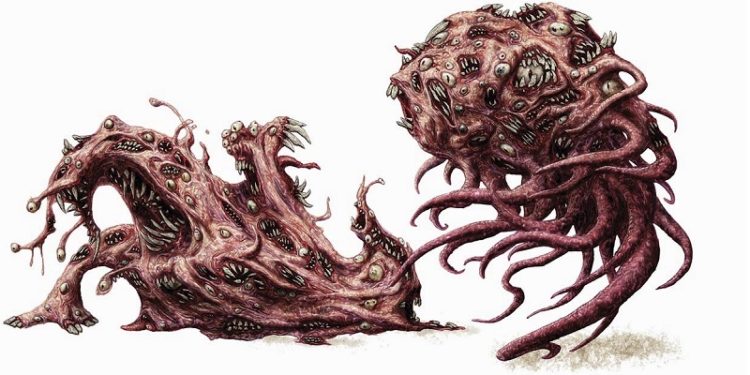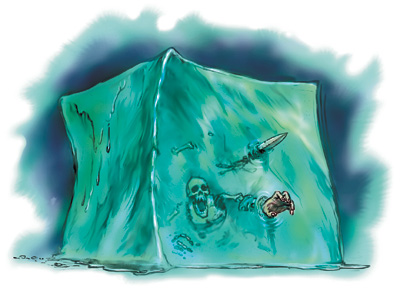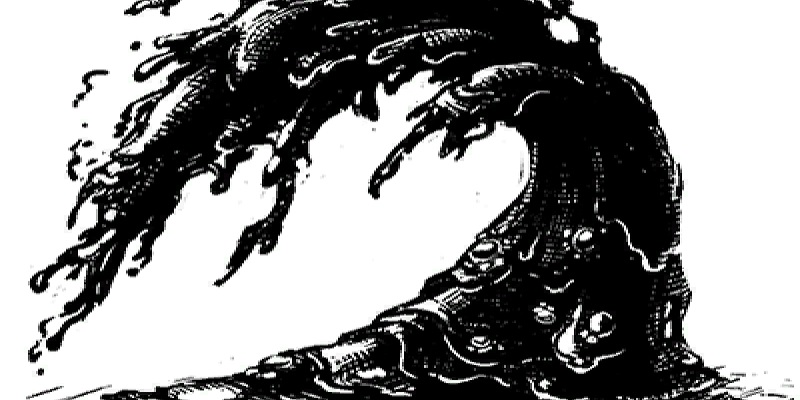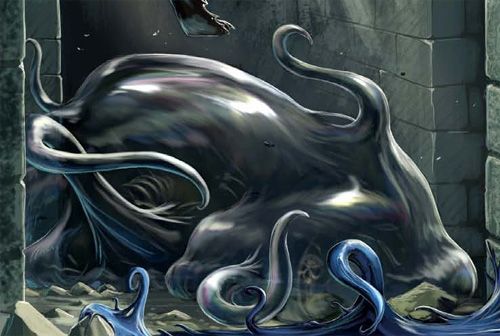Slimes: Cooler than you might think

(note: when reading this article, the advice herein applies equally to oozes, jellies, in addition to the titular slimes, though I won’t always call it out in the article, so as not to be repetitious.)
When most people hear the words “slime” in the context of a RPG game, they feel that these enemies, for the most part, are beneath their notice. Yet these creatures, for all their similarities and simplicity, are awesome if they are used properly and can be used to challenge even the most powerful of characters.
Slimes, oozes, and jellies – and even such things as gibbering mouthers, mudmen, and mimics – are amorphous due to their unique lack of anatomy, these creatures range from mindless eating machines to tricky shape-shifters or something in- between, depending on their exact type. Their creation stories can be varied: everything from a psychic phenomenon from emotions coalescing into the ooze in the case of the Emotion Ooze to natural phenomenon dating back to the creation of the universe to horrors from another universe to a scientific experiment or magical experiment gone awry to a miscast spell (as in the case of the mustard ooze). They can serve the roles of everything from distraction to dungeon cleanup to deadly enemies to assassins. Among the reasons these enemies are omnipresent in games is because of their versatility.
Slime Traits
Generally speaking, slimes, oozes, and jellies have the following traits:
(Note: these traits are based on D&D/ Pathfinder. Individual rules for your specific system may vary)
Amorphous: Slimes, oozes and jellies lack discernible features, allowing them to “flatten” themselves out to get into the tiniest of places. This makes them similar to the real world cephalopods and hagfish.
Mindless: immune to all mind-affecting effects (charms, compulsions, illusions, phantasms, patterns, and moral effects). Even ones with rudimentary intelligence may be highly resistant to such.
Blind (but have the blindsight special quality), with immunity to gaze attacks, visual effects, illusions, and other attack forms that rely on sight.
Immunities: poison, sleep effects, paralysis, polymorph, stunning, flanking, precision-based and critical attacks. Some may be immune to piercing and slashing weapons, as well as damage based in some elemental damage.
Vulnerabilities: Depending on the specific variety, though if they are immune to one type of elemental damage, they’re usually vulnerable to its opposite. For instance, some oozes may be infused with negative energies, thus making them vulnerable to positive energy based attacks.
Special Damage: Many slimes, etc. have the ability to deal acid damage to objects.
Skills: Many Slimes are quite observant, having ranks in perception, climb, and are quite proficient in using their bodies to slam or en.
Weapon / Armor Proficiencies: Natural weapons (slam attack, engulfing attack), no armor.
Slimes, oozes, and Jellies eat and breathe, but do not sleep.

Challenging Players with Slimes
Due to their multitudes of creation myths, there are a variety of ways to challenge your players/ NPCs. Note, not all of these ideas / abilities may be from D&D/ Pathfinder.
- Instead of being mindless eaters, slimes, oozes, and/ or jellies could be picky about what they eat. Some may target specific races first, others may find magic/ divine powers tasty, stealing random spells (or spell slots), and still others may have a favorite metal or gem that they will seek out above all others.
- Maybe their appetites are a bit more specific, and they survive by draining their meals of their bones. Or, maybe, if they’re a species that lives in cold weather climates, they might find prey by locking onto and consuming their victim’s warmth. If they’re in a dry climate, the slime might have a desiccating attack that allows them to gain their nutrients that way.
- An ooze could be so giant that it constitutes the environment itself, as in the Living Lake.
- Possible slime defenses
- Retaliatory strike that doesn’t count against the number of attacks per round it has.
- Fast Healing
- Explosive
- Adaptation
- Regeneration
- Electrical Discharge (and drain)
- Splitting instead of taking damage
- Stickiness
- Poison
- Fascination
- Object duplication (mimic, deathrap ooze)
- Solidification (making its exterior the same hardness as rock)
- Paralysis touch to its foes.
- Immunity to various types of weapons (piercing, slashing, bludgeoning)
- Creation & detection of extra-dimensional spaces, such as in a bag of holding
- Virtual Spell Casting. Some of the spells or spell like abilities various slimes have are:
- Sleep
- Magnetism
- Grease spell
- Greater Invisibility
- Fear
- Charm/ Compulsion
- bestow curse
- confusion
- Entangle
- hold person
- Death Watch
- Rather than being completely mindless, they can imitate the intelligence of other creatures they mimic. Conversely, the ooze could have the intelligence of a standard human(oid).
- Instead of being slow moving creatures that the PCs almost literally have to stumble or fall into, or, conversely drop onto hapless heads from above, allow them other forms of travel. Maybe allow them a more humanoid method of locomotion, using their pseudopods to run, allow them to form a humanoid or quadruped shape, or allow them to zip around the dungeon(s) and other environments they appear in with lightning fast speed(s). Or perhaps they have teamed up with something with a bit more structure that allows it to glide from place to place. Certain oozes can either float midair like the Cerebric Cyst or fly under its own power such as an ooze known as the Color Out of Space. Conversely, they could have tendrils stretching massive distances to get from point A to point B, literally running over or or bull-rushing through anything in their way. A particularly clever group of slimes or one with a particularly long reach might string themselves through trees to “clothesline” the unwary, setting up a rudimentary web and to get an easy meal in the process. Finally, it’s also feasible that they have the ability to teleport to get around.
- Instead of being enemies per se, perhaps they could be friendly sources of material components to harvest and sell, as in the Slime Rancher game.
- There could be other motivations the slime could have other than simple nutritional value of those that it hunts.
- It could seek to engulf its prey in order to preserve it for another time.
- It could be intelligent enough to try to retake an entire area, such as primordial forces known as blights. These oozes are powerful enough that a good chunk of a campaign could be designed around their machinations.
- It could seek to spread disease.
- It could seek to survive by cannibalism.
- Instead of hunting for sustenance, it could be designed to make others of its own kind.
- It could seek prey to help with its reproduction.
- It could want to create vermin, juju zombie, or skeleton guards for itself
- It wants to help adventurers by healing them or providing them with armor
- It wants to merge with a creature to make an entirely new race.
- It wants to use its abilities to destroy evil.

A Baker’s Dozen Slime Plots
- Someone is using a more controllable version of Amber Ooze or perhaps an Insidious Ichor to gain influence over a king. Can the PCs discover the plot to take over the kingdom in time?
- A necromancer is working with an undead or vampiric ooze to terrorize a land. Can the PCs stop them before they get too powerful?
- A “Tear of Burning Flame” has offered a spellcaster an unholy alliance, who accepted its terms. Can the PCs defeat them before they becomes the second stage in their evolution?
- There’s tales of these weird puddles in the haunted forest that give visions of the future, but they’re, in reality Warpglass Oozes working together. Can the PCs track them down and eliminate them before a predictable disaster occurs?
- A Blight has appeared and is attempting to take over the area. Can the PCs stop it before it is unstoppable? Remember blights come in Cave, Desert, Forest, Mountain, Sewer, Swamp and Tundra verities. Due to the vast differences in the types of environments and locals one can find them in, one could conceivably start level one players from encountering their machinations from level 1.
- A scientist is trying to create cures for diseases that have been plaguing his area due to a cleric of disease in the area and inadvertently creates boilborn or hungry flesh instead.
- People are dying mysteriously in a graveyard due to a Hungry Fog. Can the PCs figure out what’s going on before more people die?
- A group of wild Elves are using a Living Lake to keep their land safe from trespassers. Unfortunately, the PCs need to contact them because they have knowledge of a cure for a loved one. Can the PCs get past the lake or will they have to defeat their god?
- You and your party members self aware, free acting slime and you have to make your way in the world.
- A conflagration ooze is trying an experiment… unfortunately, for those in its path, the experiment it’s conducting is causing widespread havoc. It’s up to the PCs to stop it by any means necessary.
- (Eberron only)The players have been notified a living spell has appeared in the area. It’s up to them to capture it.
- An Ooze acting as a spy has infiltrated the kingdom for a foreign land, it’s up to the PCs to ferret it out.
- A mage is using a series of linked capacitor oozes to power an entire city. One of the oozes has escaped and is wreaking havoc. It’s up to the PCs to capture it and bring it back safely. The question is how.
I hope these ideas on how to make slimes a more integral part of your game were interesting and useful.




